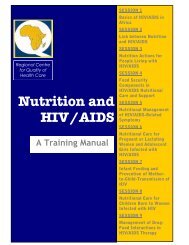2.1: Anthropometric Indicators Measurement Guide - Linkages Project
2.1: Anthropometric Indicators Measurement Guide - Linkages Project
2.1: Anthropometric Indicators Measurement Guide - Linkages Project
You also want an ePaper? Increase the reach of your titles
YUMPU automatically turns print PDFs into web optimized ePapers that Google loves.
REFERENCES PART 9.<br />
The correction from Collins et al. (2000)<br />
for standardizing BMI using the Cormic<br />
Index (SH/S percentage) applies the<br />
following formula:<br />
Male BMI = 0.78 (SH/S) – 18.43<br />
Females BMI = 1.19 (SH/S) – 40.34<br />
The reader is referred to Collins et al.<br />
(2000) for the use of the Cormic Index for<br />
comparing across population groups<br />
where an average for the Cormic Index<br />
can be used. For individuals, their own<br />
Cormic Index should be used to correct<br />
the BMI.<br />
BMI changes during pregnancy. It will be<br />
necessary to separate pregnant women<br />
from non-pregnant women when comparing<br />
BMI.<br />
In summary:<br />
• For comparisons within populations<br />
over relative short times for evaluation<br />
purposes, BMI should not require a<br />
correction using the Cormic Index.<br />
• Assessing or screening individuals for<br />
targeting using BMI should correct the<br />
individuals BMI using the Cormic Index<br />
for that individual.<br />
The authors of the ACC/SCN review<br />
(Collins et al., 2000) conclude that in<br />
situations of emergency screening, the<br />
measurement of height and sitting height<br />
and the use of the Cormic Index correction<br />
is time consuming and mostly unrealistic.<br />
In situations of famine relief, they caution<br />
that without the standardization with the<br />
Cormic Index, the use of BMI alone for<br />
screening is inappropriate. BMI<br />
measured during emergency situations<br />
requires good equipment, well-trained<br />
personnel and an ability to convert the<br />
measures into the BMI. Challenges in<br />
measuring people who are very sick,<br />
elderly and disabled may make the use of<br />
BMI for screening even more difficult.<br />
In addition to a Cormic Index correction,<br />
the age distribution is important. As<br />
people grow older, the distribution of fat<br />
and fat free mass (water, bone and<br />
muscle) changes. For screening purposes,<br />
BMI may have to be adjusted for age.<br />
There is no guidance for this at the<br />
moment. For evaluation purposes, as long<br />
as the distribution of age in the baseline<br />
and follow up remain the same, the biases<br />
will be consistent and age should not<br />
confound the analysis of change. Where<br />
age is a potential confounding variable,<br />
data may have to be presented for age<br />
group which has assessment implications<br />
(not all respondents know their ages) and<br />
sample size estimations (stratification of<br />
the sample increases size requirements).<br />
4.3 Mid-upper arm circumference<br />
(MUAC)<br />
MUAC is the circumference of the left<br />
upper arm measured in centimeters. The<br />
point is between the tip of the shoulder<br />
and the elbow. The use of MUAC and the<br />
equipment for the measurement is<br />
detailed in section 5 of this <strong>Guide</strong>. Arm<br />
circumference is measured with special<br />
circumference measuring tapes or<br />
circumference insertion tapes.<br />
Because the equipment is lightweight<br />
and training to do MUAC is<br />
straightforward, MUAC is utilized for<br />
screening in emergency situations when<br />
nutritional status information is needed<br />
immediately for large groups of people,<br />
especially children. The indicator is useful<br />
for assessing acute adult undernutrition<br />
and for assessing the prevalence of<br />
undernutrition at the population level.<br />
While arm circumference measures<br />
both muscle and fat, some populations<br />
would be expected to have very little<br />
subcutaneous fat on their arms. A low or<br />
decreasing arm circumference for these<br />
populations would signal the loss of<br />
muscle mass, a serious sign, possibly<br />
indicative of protein-energy malnutrition<br />
or starvation. MUAC is usually unaffected<br />
by edema common in famine, and is a<br />
sensitive reflection of tissue loss and is<br />
independent of height.<br />
The use of MUAC for emergency<br />
program screening has limitations. The<br />
choice of cutoffs is challenging as there is<br />
a lack of an understanding of the<br />
functional significance of different levels.<br />
9.<br />
77

















